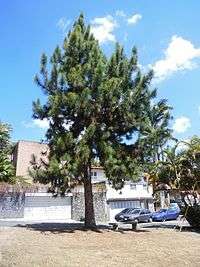Caribbean pine
| Caribbean pine Pinus caribaea | |
|---|---|
 | |
| Pinus caribaea specimen in El Hatillo, Miranda, Venezuela | |
| Scientific classification | |
| Kingdom: | Plantae |
| Division: | Pinophyta |
| Class: | Pinopsida |
| Order: | Pinales |
| Family: | Pinaceae |
| Genus: | Pinus |
| Subgenus: | P. subg. Pinus |
| Section: | P. sect. Trifoliae |
| Subsection: | P. subsect. Australes |
| Species: | P. caribaea |
| Binomial name | |
| Pinus caribaea | |
 | |
| Natural range | |
| Synonyms | |
|
Pinus hondurensis Sénéclauze (but see text) | |
The Caribbean pine, Pinus caribaea, is a hard pine, native to Central America, Cuba, the Bahamas, and the Turks and Caicos Islands. It belongs to subsection Australes in subgenus Pinus. It inhabits tropical and subtropical coniferous forests, which include both lowland savannas and montane forests. Wildfire plays a major role limiting the range of this species, but it has been reported that this tree regenerates quickly and aggressively, replacing latifoliate trees.[1] In zones not subject to periodic fires, the succession continues and a tropical forest thrives.
It has been widely cultivated outside its natural range, and introduced populations can be found nowadays in Jamaica, Colombia, South Africa, Sri Lanka, Fiji and China.
Varieties
The species has three accepted varieties:[2]
- Pinus caribaea var. caribaea (Pinar del Río Province and Isla de la Juventud in western Cuba)
- Pinus caribaea var. bahamensis (Grisebach) W.H.Barrett & Golfari – Bahamas pine (The Bahamas, Turks and Caicos Islands)
- Pinus caribaea var. hondurensis (Sénéclauze) W.H.Barrett & Golfari – Honduras pine (state of Quintana Roo in Mexico, Belize, Guatemala, El Salvador, Honduras, Nicaragua)
Colonization of the Caribbean basin
It has been proposed that the pines of Australes subsection (of which Caribbean pine is part) arrived to the Caribbean basin from Southeastern USA.[3] Recently, paleoclimatic[4] and genetic data[5] have been used to propose that Pinus caribaea would have originated in Central America. According to chloroplast genetic data, Pinus caribaea lineages colonized the Caribbean islands from populations in Central America at least twice (one leading to Cuban populations and another leading to Bahamaninan populations).[5] Moreover, pine populations in the Caribbean basin appear to have been larger during the maximum glacial periods, due to the increase in both emerged land and dry conditions.
Conservation
According to the IUCN, this species as a whole is considered of least concern,[6][7] but two of the three varieties are considered endangered (var. caribaea)[8] or vulnerable (var. bahamensis).[9] Populations in Bahamas and Turks & Caicos Islands would be particularly vulnerable in a global warming scenario due to the increase in sea level and consequent reduction in the emerged land area.
References
- ↑ Vázquez-Yanes, C.; A. I. Batis Muñoz; M. I. Alcocer Silva; M. Gual Díaz & C. Sánchez Dirzo (1999). "Árboles y arbustos potencialmente valiosos para la restauración ecológica y la reforestación" (PDF) (in Spanish). Retrieved 2002. Check date values in:
|accessdate=(help) - ↑ "The Plant List: Pinus caribaea". Royal Botanic Gardens, Kew. 2013.
- ↑ Adams, D.C., Jackson, J.F. (1997). A phylogenetic analysis of the southern pines (Pinus subsect. Australes Loudon): biogeographical and ecological implications. Proceedings of the Biological Society of Washington 110: 681–692.
- ↑ Dvorak, W. S., Hamrick, J. L. &Gutierrez E. A. (2005). The origin of Caribbean pine in the seasonal swamps of the Yucatán. International Journal of Plant Sciences 166: 985-994.
- 1 2 Jardón-Barbolla, L., Delgado-Valerio, P., Geada-López, G., Vázquez-Lobo, A., & Pinero D. (2011). Phylogeography of Pinus subsection Australes in the Caribbean Basin. Annals of Botany 107: 229-241.
- ↑ "Pinus caribaea (Caribbean Pine, Nicaragua Pine, Pitch Pine)". www.iucnredlist.org. Retrieved 2018-08-23.
- ↑ "Pinus caribaea (pino macho) description - The Gymnosperm Database". www.conifers.org. Retrieved 2018-08-23.
- ↑ "Pinus caribaea var. caribaea (Caribbean Pine, Nicaragua Pine, Pitch Pine)". www.iucnredlist.org. Retrieved 2018-08-23.
- ↑ "Pinus caribaea var. bahamensis (Bahamas Pine, Caicos Pine , Caribbean Pine)". www.iucnredlist.org. Retrieved 2018-08-23.
